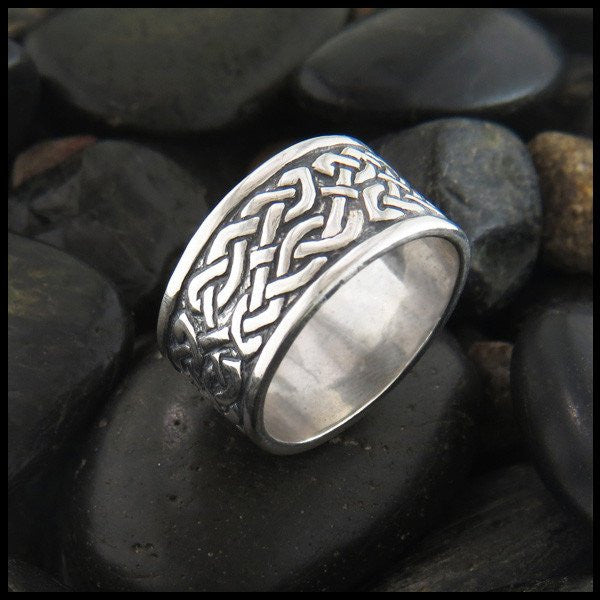- Jewelry
- Crosses
- Rings
- Mens
- Claddagh
- Wedding
- Personalized Jewelry
- John Urban Jewelry
- Sale
- Gift Certificates
- About Us

Celtic interlace designs make their first appearance in early Christian Celtic Art in the middle of the seventh century A. D.
There are three ways I expect various readers to be upset with the opening sentence of this article. Celtic interlace, that is knotwork designs as well as interlaced birds and beasts are the most recognized elements of so-called Celtic Art. In our time these designs are very frequently used to identify Celtic heritage or sympathy with Celtic ethnicity, religion or culture, thus many are passionate about the art, where it came from and what it means. I have encountered each of these objections in many conversations on the subject over many years, frequently from people who should know better.
The first protest I anticipate would come from scholars who would argue that the term “Celtic” is inappropriate to use in this period. Margaret Stokes writing in 1887 opens the preface of her book Early Christian Art in Ireland with these sentences. “The subject of the following chapters is what has been mis-labeled Celtic, Anglo-Saxon or Runic Art, whereas the style is Irish. The term Celtic belongs to the arts of bronze and gold and enamel practiced in Britain before the Roman occupation and in Ireland before the introduction of Christianity in the fifth century.”
Had I obeyed Stokes proposal and used “Irish Art” instead I would be leaving out the Pictish and Northumbrian schools of Celtic Art (there I go again) and the largely Scottish readers of this magazine might think that this was only about art that occurred in Ireland. “Insular Art” is the term preferred by today’s academics. The fact is that, although flawed, the term “Celtic Art” is the vernacular label for this style. I use the term “Celtic” for no other reason than that is what most people call it.
Much of the misinformation on Celtic subjects is a result of books and articles that present the most reliable information available in such a dry academic style that this material is not thoroughly read by most of those who look at them. Non-academic readers have a difficult time sticking to the text of books on Celtic Art, which bore even many of the most passionate about the subject. Generally readers look at the pictures and read the captions, but quickly tire of the scholarly content. This lack of discipline by the reader results in a rather sloppy understanding of the history and leads to erroneous popular generalizations and fantasies that now amount to a modern folklore about Celtic Art.
The second argument I anticipate against my opening statement comes from those who are fascinated with the pre-Christian culture of the Celts. It is very widely perceived that things Celtic have a pagan heritage. What Stokes describes as Celtic Art certainly was pagan. The interlace designs that we now call “Celtic” appeared in Irish Art and those areas that were in close association with the early Irish Church at least 200 years after Saint Patrick began his mission to Ireland in 431 A. D. Calling artwork such as the Book of Kells (circa. 800 A. D.) “Early Christian” uses the word “early” from the perspective of more than eleven hundred years later. By 800 A. D. Ireland had already begun her fourth century of Christianity.
Sorry to be such a spoilsport, but all you pagans decorating your paraphernalia with interlace designs are frequently getting clip art that originally came from the pages of Bibles. But take some consolation in this; the earliest Christian art of Ireland, that of the 5th and 6th centuries is not all that different from the pagan Celtic art that preceded it. The La Tène style of spiral ornament dominated Celtic Art until the 7th century. Even then the La Tène style did not die out when interlace appeared, it just got better. The spiral compositions that coexist with interlace designs are referred to by art historians as “Ultimate La Tène”.
My third dispute will come from those who will object that interlace is common in many primitive cultures all over the world. They will argue, “Knots, braids and weaving are universally common. You cannot say that art derivative of actual fiber interlace spontaneously begins in Celtic Art at such a late date when it was so generally practiced by so many other cultures.” True, the Christian Celts were not the first or only artists to draw or carve knotwork. They certainly wove and knotted actual cords as all cultures have. What is significant for our understanding is that renderings of interlace were not part of the graphic vocabulary used in this culture until suddenly it was everywhere and quickly evolved to a degree of sophistication and complexity that is unsurpassed in other cultures that have made interlace designs. By the 8th century interlace was the defining characteristic of Celtic/Irish/Insular Art.
There are two schools of thought about how interlace entered the vocabulary of Celtic Art. The Germanic/Nordic influence position on the question claims that with the conversion of Northumbria to Christianity in the early 7th century, there was an artistic cross-pollination. In 635 a new monastery was established on Lindisfarne in the Anglo Saxon kingdom of Northumbria. King Oswald of Northumbria had taken refuge on Iona during years of dynastic turmoil and exile from his kingdom prior to him ascending the kingship. There he became fluent in Gaelic and studied with the monks, whom he eventually invited to send a mission to his kingdom. The earliest Christianity practiced in Northumbria was thus based on the Irish church. Interlaced abstract animal forms, although much simpler than what was to emerge later, were a part of the Germanic Anglo-Saxon tradition. The animal interlace in Celtic Art almost certainly grows out of this tradition. The term Hiberno-Saxon Art has been used to describe Celtic Art of this school.
The second school of thought has it that there are Coptic or Syrian prototypes for the manuscripts such as the Book of Durrow, There are manuscripts in from the Middle East and Coptic Egypt from the 5th and 6th centuries with knotwork interlace ornament as well as iconographic similarities in the figurative illustrations. How, we might well ask, did books from such distant places ever make it to the Insular Celtic world? Why should we prefer to think that influences from these sources are credible given the Northumbrian connection being so much easier to explain?
The Venerable Bede records that in the 7th century a Frankish bishop named Arculph who was returning from a pilgrimage to the Holy Land lost his course in a storm and landed on Iona. Abbot Adomnán had the man dictate a description of Palestine which was entitled De Locis Sanctis [Of the holy places]. Trips of this kind were still very rare but they were beginning to occur with more frequency. It is possible that Arculph or someone like him introduced books from the Middle East decorated with interlace ornament in this way. It should also be noted that were numerous displaced Christians resulting from the rise of Islam and the expansion of Arab culture at this time. By the time of Adomnán, people were coming to Iona to study from England and the Continent. Contact with Rome was reestablished after centuries of isolation. Ideas were beginning to travel in ways that they had not since the fall of the Roman Empire. This flow of ideas went both to and from the Celtic world.
Comments will be approved before showing up.

Many people don’t understand that this kind of small-town life still exists in America. You might think in stereotypes like Mayberry, but there aren’t really towns like that anymore, are there? Not Mayberry exactly, but yes, something similar and half a century later.

Ai”, has crashed the Celtic Festival, drunk, pushy, and getting in everyone’s face with some of the most obnoxious and un-authentic Celtic art of all time

We have included our favorite tips & tricks to get those improvised engagement photos looking like a professional photographer was hiding in the bushes.
Iaraterezinhadeazambujarocha
November 22, 2015
Your article shows a beafuitul Interlace ring made with silver and gold woven through it. Silver out side and gold inside. Of the 4 pictures in the article it is the upper left ring. I am really interested in IT. but can not find any information on it. If possible, check it out and let me know all about it.Thanks. Bernard Andris